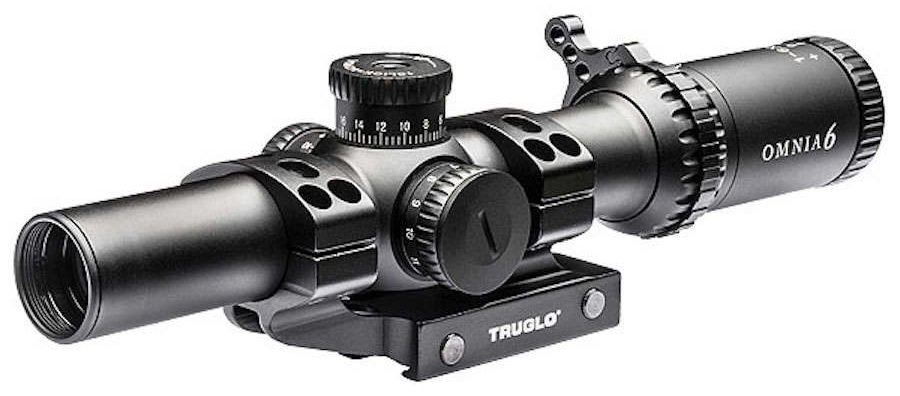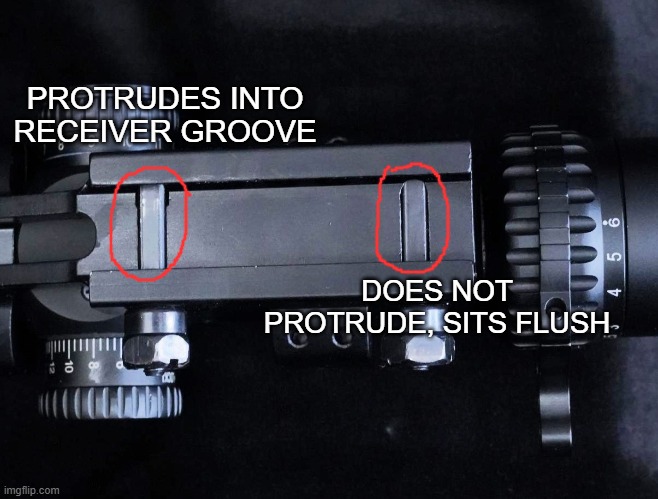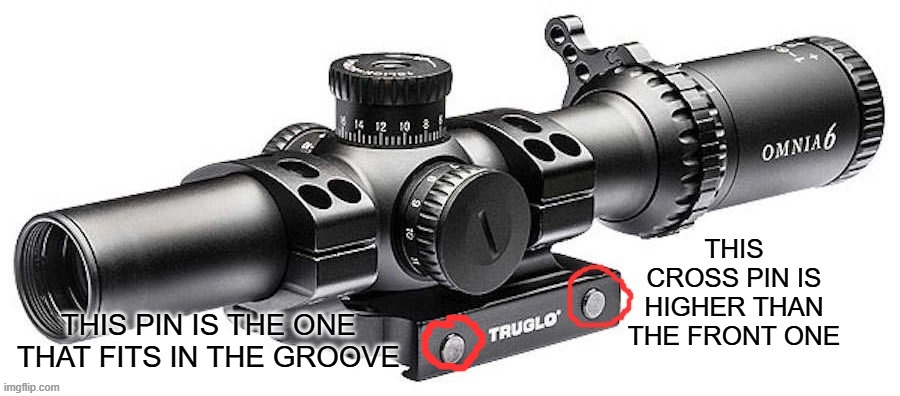SIGforum.com  Main Page
Main Page  Mason's Rifle Room
Mason's Rifle Room  Question about a scope I bought - disregard, different purchase made
Question about a scope I bought - disregard, different purchase made
 Main Page
Main Page  Mason's Rifle Room
Mason's Rifle Room  Question about a scope I bought - disregard, different purchase made
Question about a scope I bought - disregard, different purchase madePage 1 2
Go  | New  | Find  | Notify  | Tools  | Reply  |  |
| His diet consists of black coffee, and sarcasm.  |
A TruGlo Omnia 1-6x24 like this one:  Something doesn't look right about the mounting. I can't take a picture myself worth a damn, but found on Bing and edited this pic from Gunbroker. It looks exactly like mine. The Gunbroker webpage it was on no longer exists, so I have no context.  It does lock on firmly with no play even before tightening the nuts, but it doesn't seem right. I don't like that the support in the receiver groove is all on one end. This seems like there would be a potential for the scope to loosen.This message has been edited. Last edited by: egregore, | ||
|
quarter MOA visionary |
Don't know if it is by design or not. Could be worth a question to the manufacturer. Does it fit snug? Any movement? Look straight? Change POI? | |||
|
| His diet consists of black coffee, and sarcasm.  |
I just noticed something.  There is no distortion or skewed perspective in the picture; my scope looks exactly like that. I think it's on purpose. | |||
|
| Member |
It looks like a design flaw in the base IMO. It may -- or may not -- result in challenges maintaining a zero down the road. | |||
|
| His diet consists of black coffee, and sarcasm.  |
^^^ I don't disagree. Another observation: the clamp has similarly offset holes, so it only goes one way. And the anomalous cross pin (mounting bolt) is in a groove that is visibly, significantly deeper than the "correct" one. But it looks purposeful, not makeshift or damaged in any way. Some other brands of scopes I looked at with this kind of mount don't look like this, however. While the mount seems to fit snugly, wiggling with your hands isn't the same as recoil forces. I think this is a feature we're not seeing, but I have an e-mail put in to them and will await their response. They also have a phone number. | |||
|
Firearms Enthusiast |
Have you tried rotating the high pin 180* to see if it has a high/low side? | |||
|
| Member |
I'm trying to find an answer online and i can't. Every Truglo APTUS mount though is the same. I'm tempted to contact truglo and ask what the point of this is. Nine years to retirement! Just waiting! | |||
|
| His diet consists of black coffee, and sarcasm.  |
I tried moving it, but no reasonable amount of force would budge it in any direction. To rotate it, it would have to be round, but other than where the nut threads on it appears square in cross-section. | |||
|
| Wild in Wyoming |
I wonder if it is designed that way to fit better/work on a 20 moa picatinny rail? PC | |||
|
| Member |
It won't make a difference. 10, 20, 30, whatever MOA rails are flat on their top side, just like a 0 MOA rail. Bottom line is that the mount's rear crossbar wasn't designed/manufactured to engage a groove in the pic rail. This rear bolt/crossbar only functions as a clamping/friction device on the sides of the pic rail, but it doesn't appear to provide the stability that comes when a crossbar engages the pic rail's grooves. | |||
|
| Freethinker |
This question has piqued my interest, but I’m not sure what’s being asked. Is it that there is only one crossbar that extends down from the bottom of the mount to fit into a Picatinny-type rail slot and that seems to be a flaw when there should be two? The picture below is of the bottom of a Spuhr scope mount which are considered by many shooters to be among the best and most stable. As we can see, the mount has only one crossbar that fits into a Pic slot. The screws also fit into slots, but they’re not intended to add to stability except through their clamping force. I have owned many Spuhr mounts and all have been perfectly satisfactory for me.  Having more than one crossbar to fit into a slot would run the risk of causing a problem if the crossbars and slots didn’t match up exactly, or if someone wanted to use such a mount on something like a Weaver base that didn’t have a multitude of slots. If I understand the question correctly, I don’t believe there is anything to be concerned about. ► 6.0/94.0 To operate serious weapons in a serious manner. | |||
|
| His diet consists of black coffee, and sarcasm.  |
^^^ In that Spuhr mount, the cross bar is in the middle, not way out on one end, and there are two mounting bolts per end. That, I like. It does look massively overbuilt and high quality ... but the price tag, in a quick search, doesn't leave me much for a scope. Thanks for showing it, though, I had no idea it existed. This is going on Picatinny rail. For a Weaver mount, the instruction manual says to purchase different rings. It also says that the user has to do the final leveling and provides hex keys for the ring screws. I'm 99% sure this is a design feature (possible cost cutting measure to make one part do the job of two) and will... probably work just fine for my use. But there's always that 1% ... | |||
|
| Freethinker |
Yes, Spuhr mounts are expensive, and I bring it up as an example to show that a single crossbar is probably the most common (only?) design, not a flaw. Although I haven’t researched the issue in depth, I’ve seen references to other similar mounts these days that don’t cost as much. They may still be significantly more than you’d like to spend to mount a scope like that, though. It’s often said that for precision rifle shooting spending more on the scope than the gun isn’t unusual, but I admit that’s probably not true of spending more on the mount than on the scope. As for your scope, what rifle/cartridge do you plan to use it with? Big, heavy scopes and hard-recoiling guns and cartridges require stouter mounts, but that scope isn’t big and heavy, and if you were planning to use it with something like an AR in 223/5.56, I believe it would probably work fine, which is why it is made that way. ► 6.0/94.0 To operate serious weapons in a serious manner. | |||
|
| Sigless in Indiana  |
It's likely due to them not wanting to put the effort and detail into the design and machining to ensure that the pins line up perfectly with a picatinny rail. Conversely, this will allow it to fit on rails that are out of spec, which would be their likely excuse. An out of spec AR upper would be a rarity in this day and age, but stranger things have happened. One lug should be sufficient on a mild recoiling rifle like an AR in 223. | |||
|
| His diet consists of black coffee, and sarcasm.  |
I'm inclined to agree. They could have put the lug in the middle with a bolt (one would do) on each end, too. As scopes go, this is on the lower end of pricing, better than a cheap one like Tasco but way below a $300 mount and a $1000, $2000 or even more scope, made in China, and going on a $500 rifle. But I can't afford the high-end products and won't be going to the sandbox, jungle or Ukraine/Russia during rasputitsa, or any "high speed/low drag" training courses. Nevertheless, I am going to do some more shopping around. | |||
|
| Member |
Looks like a poorly made in China product.... Jeeps...guns...German Shepherds! | |||
|
| Sigless in Indiana  |
I would give it a shot as is. One lug should be plenty for the recoil of an AR. You can always swap it out later if it gives you trouble. | |||
|
| His diet consists of black coffee, and sarcasm.  |
^^^ I'm sure you're right, but despite the reassurance, I'll just never be happy with it. Decided to send it back and save up for a little better setup. There are plenty of choices in-between the low and high priced ones. | |||
|
| His diet consists of black coffee, and sarcasm.  |
? | |||
|
| Freethinker |
That usually refers to mounting rails that are attached directly to the rifle and increase the effective elevation of the sight by being higher at the rear than at the front, i.e., angles the scope down with respect to the bore line. It’s the same as raising a rear mechanical sight to make the bullet point of impact higher. Some scope mounts like those in the Spuhr line can also add elevation in the same manner. The purpose of having a rail/base that adds minutes of angle (or milliradians) to the elevation is to permit shooting at long range without running out of internal scope elevation. For example (using arbitrary figures), let’s say that we needed 60 minutes of angle of elevation to hit a target at 1200 yards, but the scope only had a total of 80 MOA total internal movement, which would mean that it could be dialed up only 40 MOA from the center position. A calibrated reticle might permit holding up the extra 20 MOA needed, but that might not be the best for shooting. Plus there can be disadvantages to dialing a scope’s elevation to the maximum possible. If, however, our scope base/rail already added 30 MOA of elevation, then we’d need to dial up the scope’s elevation only 30 MOA to get to the total 60 MOA elevation required for the shot, and that’s the purpose of such rails. Adding a +MOA mounting rail or scope mount isn’t, however, without its possible drawbacks which don’t always get mentioned in discussions about elevation-adding bases. If all our shots are at close ranges, then we’ll have to dial down from the reticle’s center position and that can cause the same mechanical/optical problems as having to dial up too far. I have +6 milliradian (+20.25 MOA) Spuhr mounts on most of my rifles, but as I’ve never shot at targets with centerfire rifles farther than 1000 yards, in theory at least it would be better if they didn’t add to the elevation of the system. For shooting 22 Long Rifle at 400 yards, though, that’s another matter. ► 6.0/94.0 To operate serious weapons in a serious manner. | |||
|
| Powered by Social Strata | Page 1 2 |
| Please Wait. Your request is being processed... |
|
SIGforum.com  Main Page
Main Page  Mason's Rifle Room
Mason's Rifle Room  Question about a scope I bought - disregard, different purchase made
Question about a scope I bought - disregard, different purchase made
 Main Page
Main Page  Mason's Rifle Room
Mason's Rifle Room  Question about a scope I bought - disregard, different purchase made
Question about a scope I bought - disregard, different purchase made© SIGforum 2025